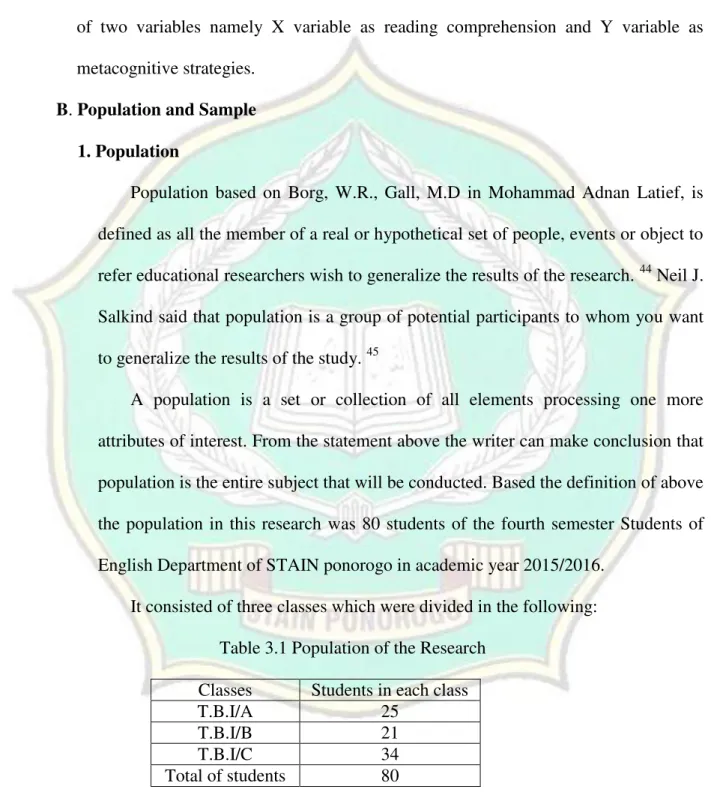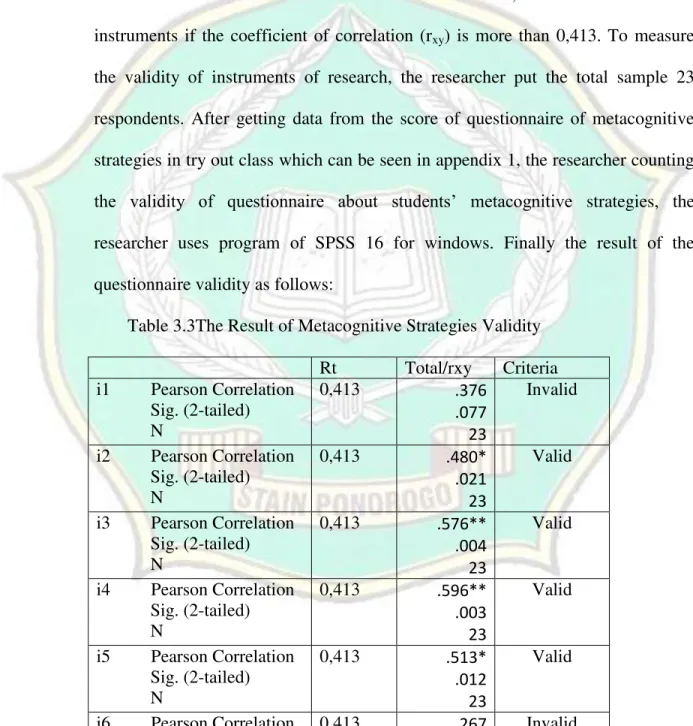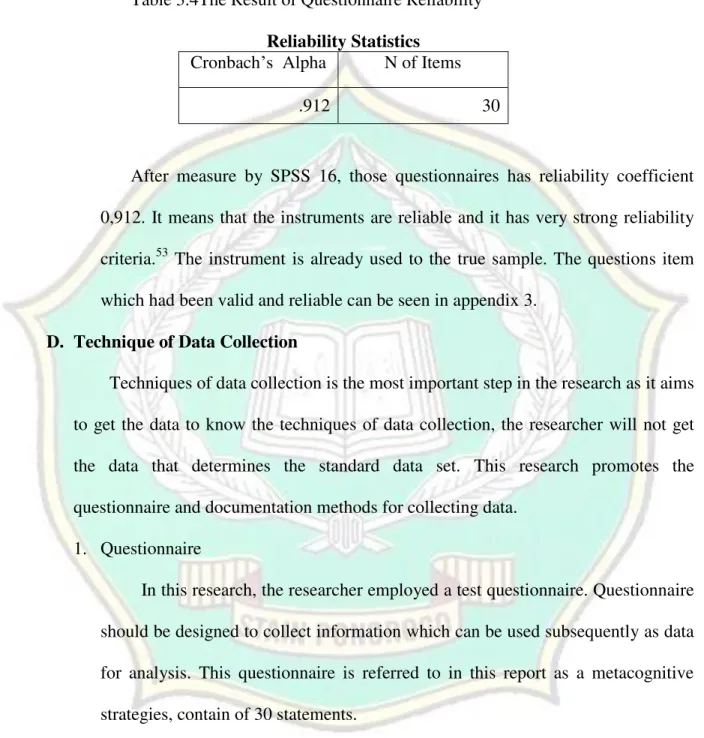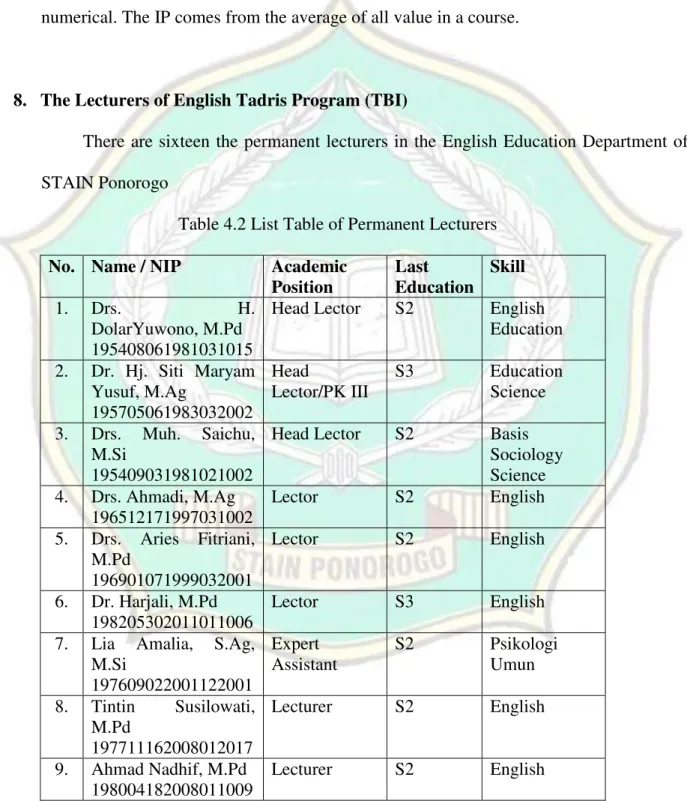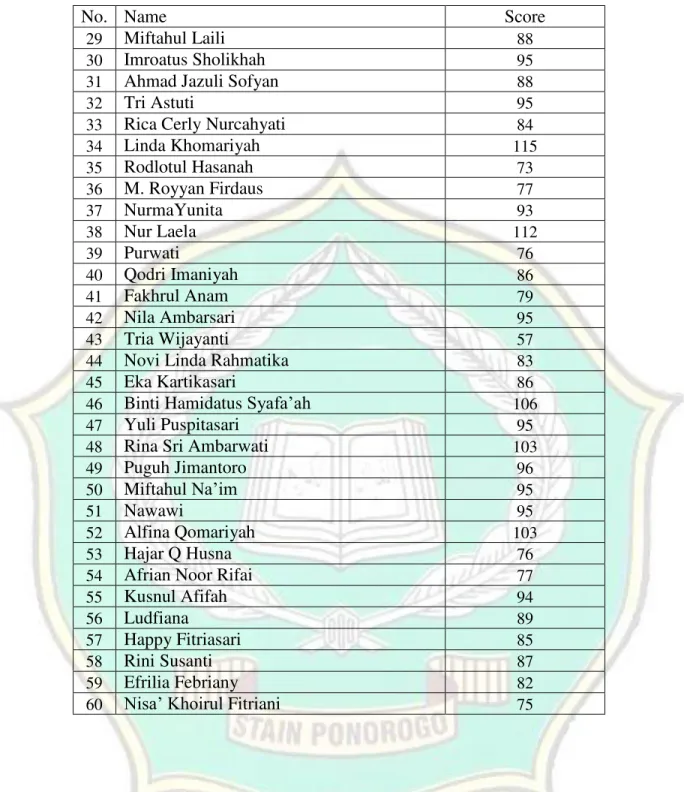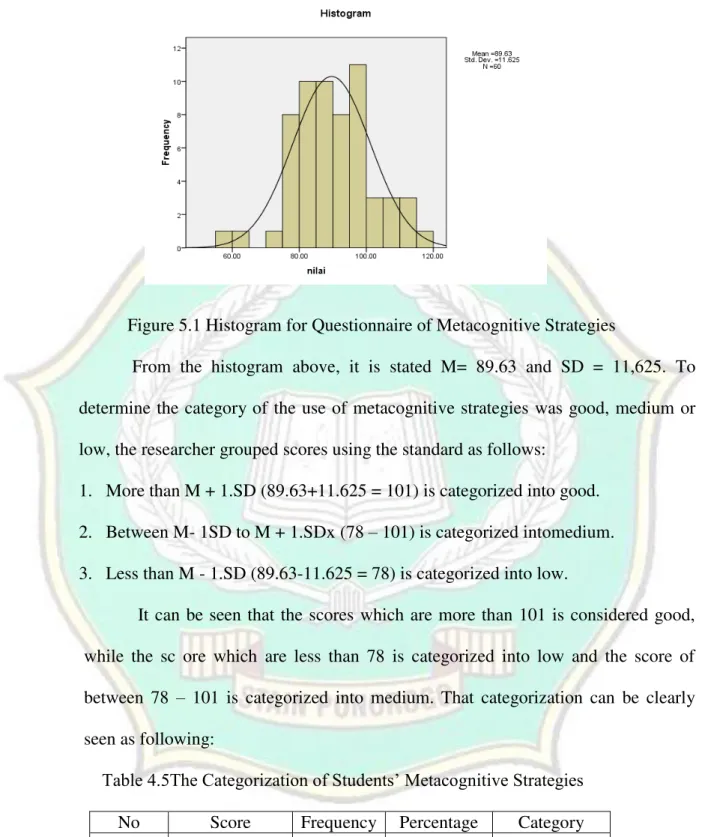The main purpose of reading is to gain knowledge and understand the content of the books and benefit from them. Strategic reading is defined as the ability of the reader to use a wide variety of reading strategies to achieve a purpose for reading.
Micro Skills for Reading Comprehension
Recognize cohesive devices in written discourse and their role in signaling the relationship between and among clauses.
Macro Reading Skill for Reading Comprehension
During the reading activity, there will be some clues that will affect the students' reading performance. However, students will find it difficult to understand texts in practice if they read orally.
Skimming and Scanning
Extensive reading extends to more than one page of text, which can be essays, articles, technical reports, short stories, and books. 15 Although students read longer texts, they still need to understand the text as the main purpose of reading.
Understanding Difficult Texts
Questioning as You Read
Highlighting and Annotating
Making Note
Summarizing
Critical Thinking
In the teaching of reading, it is expected that the teacher gives the students the opportunity to read the texts in detail. The teachers are expected to choose good reading assignments that can be interactive for the students.
Reading Comprehension
Words
Sentences
Paragraphs
Whole selection
If the reading material is written in the language the student is learning, his comprehension will be limited. He should first be fluent in the spoken language before attempting to understand any but very basic literature.
Metacognitive Strategies
This method is based on discussion aimed at connecting what the reader already knows and what he/she encounters in the text. In the experience step, the teacher leads the students in discussion about their own knowledge or experiences related to this. In the text step, students read short parts of the texts; usually a page or two, and the teacher asks questions about the content after each section is read.
In the final step, the relationship sequence, the teacher attempts to help students make relationships between the content of the text (as developed in the text step) and their external experience and knowledge (as discussed in the experience step). steps that the teacher attempts to model and systematically guide students through the cognitive processes associated with understanding a written text. Finally, our results show that there are significant interactions between students' learning styles and the effectiveness of training in the two different strategies.32.
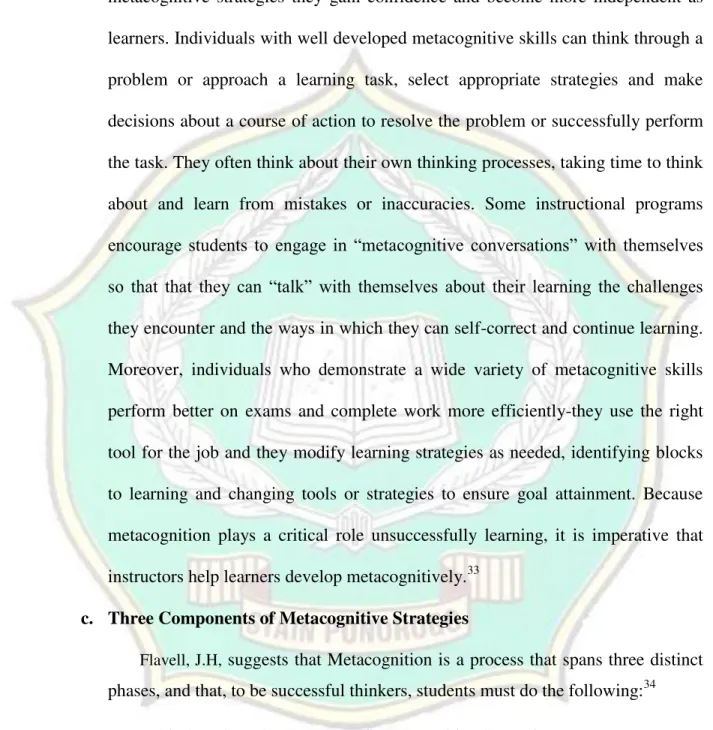
The Advantages of Learning Metacognitive Strategies
Advantages and Disadvantages of Learning Metacognitive Strategies However, metacognitive has many advantages and disadvantages. The use of metacognitive strategies such as self-awareness and self-monitoring aims to develop independent learners who can control their own learning and learn how to learn for life.
Disadvantages of Poor Metacognition a. Poor self-esteem
Track their impressions as they read and identify the underlying meaning of the text.
Correlation between Metacognitive Strategy and Reading Comprehension According to Presley the current understanding of reading strategies has been
Studies of children's reading and metacognition (planning and revising strategies) suggest that skilled readers are dynamic readers who anticipate what will happen in the text. It has been claimed that when readers predict before reading, they activate past memories and experiences and test themselves if they have enough knowledge of the current topic to understand the text.38 Anticipation strategies help promote overall understanding of the story and engagement with the text. information during continuous reading and enables readers to verify their understanding of the text. They usually verify their predictions by monitoring meaning and occasionally using correction strategies, such as reading or reading when their predictions of events within the text do not come true.
The reader's conceptual understanding of the text also develops and changes over time as the reader progresses through the text.39 For example, the reader's understanding of a scenario based on a zoo as described in a passage of text depends on the reader. experiences with zoos and new information brought to the text. Comprehension is therefore more effective if readers use what they already know about the topic of the text to conceptualize the essence of the present text.40 b.
RESEARCH METHODS
Research Design
This research advanced a hypothesis: "There is a significant correlation between metacognitive strategies and students' reading comprehension in the fourth semester students at STAIN Ponorogo in the academic year 2015/2016". The hypothesis consisted of two variables namely X variable as reading comprehension and Y variable as metacognitive strategies.
Population and Sample 1. Population
- Sample
According to Charles C.M in Mohammad Adnan Latief "a sample is a small group of people chosen to represent the much larger whole population from which it is drawn."46 According to Neil J. Salkind, a sample is a subset of a population that is chosen is for measurement, observation or questioning, to provide statistical information about the population. The number of participants from each subgroup is determined by their number relative to the entire population.48.
This technique requires the method of taking a sample from each subpopulation, taking into account the size of the subpopulation of each population. To obtain the sample, the researcher took the sample from each subgroup determined by their number relative to the entire population.
Instrument of Data Collection
Validity refers to the integrity of the instrument.49 For example, an instrument designed to assess students' sensitivity to the cultural norms of others may in fact measure a student's sensitivity to detecting the responses desired by the professor or the institution that values such standards. sensitivity. Reliability is established during test development, when special populations are recruited to take the test multiple times, before the test is used for its intended purpose.50 Reliability information on standardized tests is presented in the form of statistical correlations ( which are very high) upon repeated administrations of the test in the same population. In these test steps, the questionnaire contains 30 statements with 5 answer options for each statement and the documentation contains the students' score.
To measure the validity of the instruments in this research as the product moment formula. This means that the numerical results produced by the indicator do not change due to the characteristics of the measurement process itself or the measurement instrument.51 Reliability is the consistency of the result if the indicator or question is repeated under similar conditions.
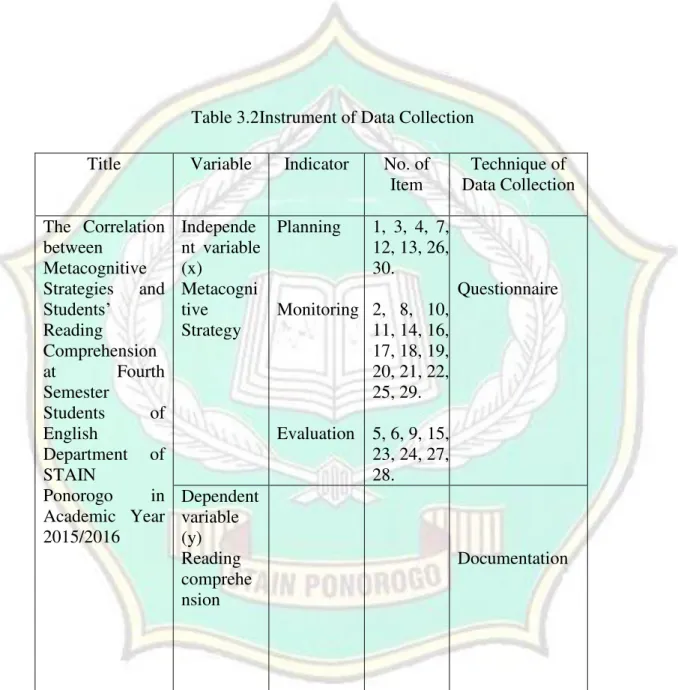
Technique of Data Collection
This means that the instruments are reliable and they have very strong reliability criteria.53 The instrument is already used to the real sample. The question item that was valid and reliable can be seen in appendix 3. summated rating scale) assesses attitudes towards a topic by presenting a set of statements about the topic and asking respondents to indicate for each one whether they strongly agree, agree, undecided, disagree or strongly disagree. Documentation is a kind of important technique to get data about everything or variables that are in the form of note, transcript, book, newspaper, magazine, meeting result, agenda, etc.
In this research, the documentation was used for the data on students' condition, school profile and students' reading comprehension in the fourth semester Students of English Department in STAIN ponorogo in the academic year 2015/2016.
Technique of Data Analysis
The requirement test uses the parameter formula whose data is assumed to be normal.54 Therefore, the study applied SPSS 16 for windows to find out the normality test. In this study, after conducting a normality test, the researcher tested the hypothesis using correlation analysis, namely Product Moment Correlation as proposed by Andhita Dessy Wulansari. Andhita said that Product Moment Correlation is a correlation technique used to discover the correlation between two or more variables.55 The formula of Product Moment Correlation is intended to “test whether there is a positive correlation between metacognitive strategies (X) and comprehension read (Y). )”.
55 Andhita Dessy Wulansari, Penelitian Pendidikan: Pendekatan Praktis Menggunakan SPSS, (Ponorogo: STAIN Po Press, 2012), 51. Adanya hasil penelitian merupakan pedoman yang baik bagi penelitian agar dapat berjalan secara teratur.
General Research Findings 1. The History of (STAIN) Ponorogo
- Visions and Missions of State of Islamic college (STAIN)Ponorogo a. Visions
- Geographical Position State of Islamic college (STAIN) Ponorogo, That verge with
- Organizational Structure of State Islamic College (STAIN)Ponorogo
- PAI 2. TBI
- The Teaching and Learning Process
- The Evaluation of Learning
- The Lecturers of English Tadris Program (TBI)
Since this change of status, State of Islamic College (STAIN) Ponorogo opened education academic and professionalism by opening three departments; Syari'ah, Tarbiyah and Usuluddin. The State Islamic College of Ponorogo is the study center for Islamic knowledge development to create the Madani communities. Implemented the learning process of Islamic knowledge and developed the academic, religious and humanistic mode.
The graduate students of the English Ministry of Education of the Islamic State University of Ponorogo are supposed to be an English teacher. The practical is teaching and learning to apply the theories, such as in laboratory and microteaching.
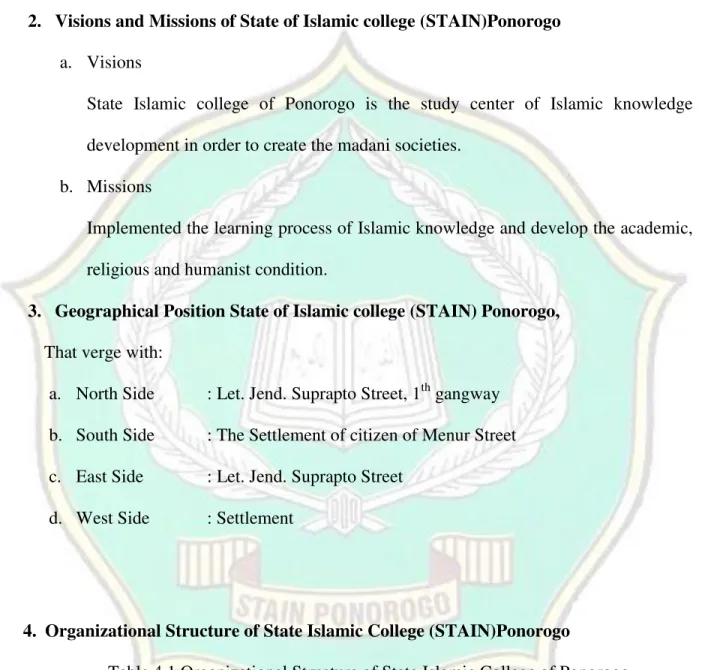
Specific Research Findings
- Metacognitive Strategies Variable
- Reading Comprehension Variable
The result of questionnaire of students' metacognitive strategies can be clearly seen on the following table. From that table it can be seen that the students' metacognitive strategies showed that 13% were in the good category, 74% in the medium category and 13% in the low category. The result of documentation about students' reading comprehension can be clearly seen on the following table.
From the table above, it can be seen that the reading comprehension result of the students was different. From this table, it can be seen that the students' reading comprehension has shown that 13% in the good category, 71% in the middle category and 16% in the low category.
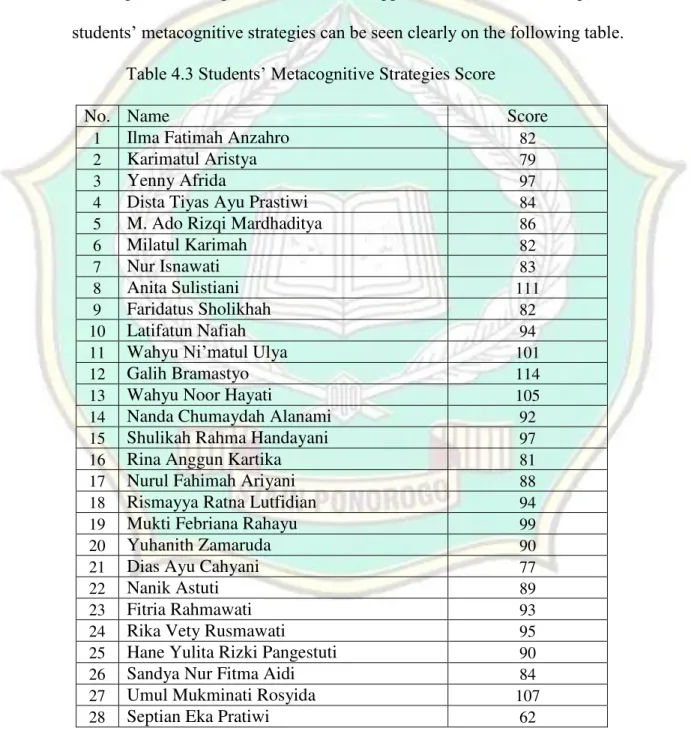
Data Analysis
- Assumption Test Analysis
- Testing Hypothesis
If the highest value of the statistic is lower than the value of the Kolmogorov-Smirnov table by a 5% level of significance, we can conclude that the data are in a normal distribution. On the other hand, if the highest value of the statistic is higher than the Kolmogorov-Smirnov table for a 5% level of significance, we can conclude that the data are not in a normal distribution.56 The value of the Kolmogorov-Smirnov table for N = 60 at the 5% level of significance is 0.250. The hypothesis of this research is that there is a significant correlation between metacognitive strategies (X) and students' reading comprehension (Y).
It means that there is no significant correlation between metacognitive strategies (X) and students' reading comprehension (Y). So, there is a significant correlation between metacognitive strategies and student's reading comprehension of fourth semester students of STAIN Ponorogo English Department in academic year 2015/2016.
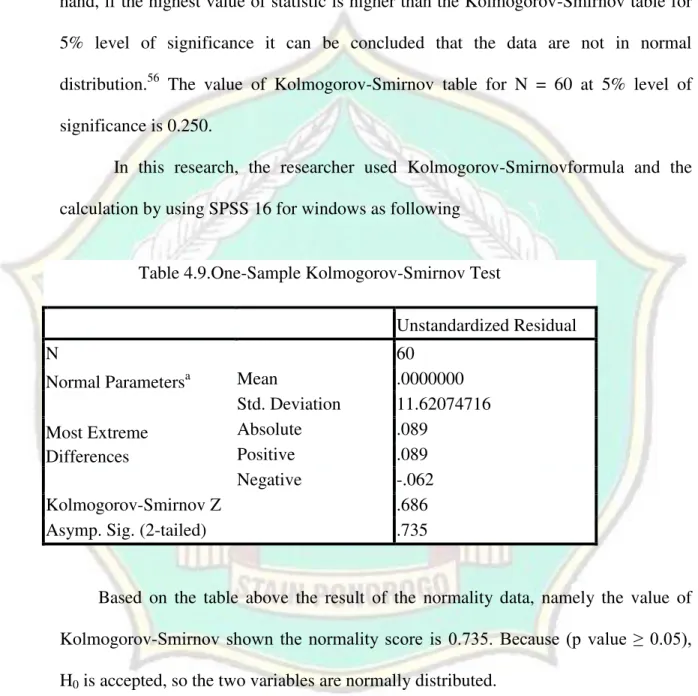
Discussion of the Research Findings
It is of great importance to improve the student's questioning skills in the process of teaching metacognitive strategies. Metacognitive knowledge involves knowing when and where to use reading strategies, and these strategies must be explicitly taught to improve comprehension. Based on the above analysis, the writer concluded that there is a significant correlation between metacognitive strategies and reading comprehension of students in the fourth semester of English Department at STAIN Ponorogo in Academic Year 2015/2016.
CLOSING
Conclusion
Recommendation
Cognitive strategies are the basic mental abilities we use to include planning how to approach a learning task, using appropriate skills and strategies to solve a problem, and monitoring one's own text comprehension. Individuals with well-developed metacognitive skills can think through a problem or approach a learning task, select appropriate strategies, and make decisions about a course of action to solve the problem or complete the task successfully. Ewan (1941) Raising Reading Achievement in Middle and High Schools, California: Corwin Press. 1979) Metacognition and cognitive monitoring: A new area for the study of cognitive development, American Psychologist.
Fraenkel and Wallen (2012) How to Design and Evaluate Research in Education, Cambridge: Cambridge University Press. Lester and Alice Crow (1976) How to Study to Learn Better, Pass Examinations, Get Better Grades, USA: Collier Macmillan Publishers.
